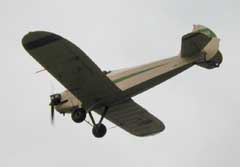 Since then, I haven't noticed much difference while
taxiing, but it
DOES seem to really have an impact on landing.
Since then, I haven't noticed much difference while
taxiing, but it
DOES seem to really have an impact on landing.
It's funny how a itty bitty change can make you have to re-learn how to land.
We were test-running Moonraker's engine during my annual in April. The A&P walked over to where I was sitting in the cockpit. "Sounds like it's idling a bit high." He glanced over the cockpit rim, where the tach needle was twitching a bit above 700 RPM. "Yep, that's a bit out of the normal range."
I actually *liked* the way the engine sounded at that speed. It was silky smooth, with none of the uncertainties and stumbling some Continentals seem to have at idle. Didn't really see how it hurt anything.
"We can leave it there if you like," said the A&P. "If we set it back a bit, you won't have to use the brakes as much when you taxi."
I didn't mention that 'Raker wouldn't keep rolling on the ground with the throttle back, even at the current idle speed. Brakes only got a workout when needing to actually stop. Not much reason to change, really.
But...I'm an engineer. If the spec says something, I like my equipment to comply, unless I've got a real good reason against it.
So we went ahead. I shut the engine down, the mechanic did his magic up forward, then I'd restart and we'd check the speed. Harry Fenton describes the process at:
http://www.bowersflybaby.com/tech/fenton.htm#a65-quits
Eventually, he got it set to about 525 RPM. A bit low (Harry says 550-650), but probably OK with a metal prop providing more rotational inertia. I cocked an ear over the coaming and listened. Not that bad, really. It still ran fairly smooth, not sounding like it was going to stumble and quit. When you get right down to it, it was a fairly genteel hum rather than the purr it previously had. We hadn't checked the tach accuracy, but I have to admit it now *sounds* like other small Continentals.
 Since then, I haven't noticed much difference while
taxiing, but it
DOES seem to really have an impact on landing.
Since then, I haven't noticed much difference while
taxiing, but it
DOES seem to really have an impact on landing.
Traditionally, I like to fly my approach a bit high to give some leeway if the engine should quit, then do a hard slip to catch the early part of the runway. I've noticed, lately, that I haven't had to slip all that much; not much excess altitude anymore.
Even more significant, the plane seems to have a TON less inertia as I pull out into the flare. That lower idle seemed to greatly increase the braking effect of the idling prop. I've been bouncing a bit lately; dropping in from a bit higher as the plane runs out of speed a bit before I expected it to.
In short, my landings have been crap.
This is simultaneously irritating...and a bit thrilling. It's irritating as my buddies slap their knees and laugh as I go bounce-jiggle down the runway.
But it's thrilling, because--well, I get to learn how to land a Fly Baby again. I used to count on a decent landing about 80% of the time, and things were getting a bit "automatic." Now the percentage is below 50%, and I'm concentrating a lot, lot more.
Also on the plus side, the plane definitely slows down quicker once all the gyrations stop. I haven't had to touch the brakes to make the center turnoff since the idle speed was lowered.
There's also the small feeling of having dodged a bullet. My higher idle didn't simulate a dead engine very well. If the engine had quit and I'd had to do a forced landing before, the extra drag would have surprised me. I might have undershot, or stalled it in, with the plane handling in an unexpected fashion. Now Moonraker's normal power-off glide is closer to what it would be if the engine goes out.
But doggone it...it really ticks me off when I start becoming a source of entertainment to all the airport bums. Again. :-)
Ron Wanttaja
Comments? Contact Ron Wanttaja.